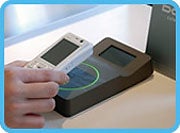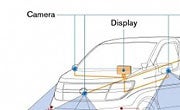True mobile TV. Connected cars. Personal robots. The coolest new gadgets and services are still found in the Land of the Rising Sun.
Just a few years ago Japan's lead in all things digital was easy to see. Japanese consumers could buy new domestic gadgets from companies like Sony, Toshiba, and Panasonic, often a year or two before they hit the market in other countries. But now things have changed. With gadgets increasingly coming out at the same time around the world, it's no longer the hardware that makes something cool, but what you can do with it.
[Note: To see some of the technology and services described here in action, watch our video, "Made in Japan: Future Tech Today."]
Mobile Digital TV

Take OneSeg, Japan's mobile digital TV system. The entire electronics industry, TV broadcasters, and the government all agreed on a single broadcasting standard, eliminating the technical competition that's holding back such services in the United States and Europe.
The result is a popular service that features all the regular terrestrial channels at no cost. Already, 14 million cell phones with the service have been sold, and the sight of people watching TV is becoming more common on trains and in cafes across Japan.
The latest phones also allow you to record TV shows. And if you're in a public space but forgot to bring your headphones, it's no problem. A couple of button presses brings up the subtitles so you can enjoy the show with the volume turned down. In addition, a companion data service provides information about the current show, promotions from the broadcaster, and, often, a link to the TV station's mobile Internet home page.
Mobile Wallet Service

Something else that's popular in cell phones these days is the "Osaifu keitai," the mobile wallet service. Phones have smart cards embedded inside, and these cards let you add applications like electronic money, your commuter pass, an airline mileage card, or a credit card just by downloading some software.
The strength of Japan's mobile wallet system is that the industry has settled on a single smart card, Sony's Felica. Once a person's phone has this hardware, he or she can add more functionality with software.

NTT DoCoMo, Japan's largest cellular carrier, gives all its customers an electronic credit card application called DCMX Mini. It has a 10,000-yen ($94) credit limit, and charges appear on the phone bill. Big spenders can apply for more credit and use it just like a regular credit card. All you have to do is bring your phone within an inch of the reader and the transaction can be completed.
Electronic money--something that was tried many times but failed during the dot-com bubble--is now becoming very popular, thanks to "Osaifu keitai."
Of the electronic money systems in Japan, Edy from BitWallet is the market leader, accepted in more than 71,000 convenience stores, bookshops, and coffee chains, and at vending machines. More than 37 million cards and cell phones that support Edy are on the market, and the network handles close to a million transactions per day on average.
Connected Cars
In Japan, car navigation systems have been a must-have accessory in automobiles for years. Streets in cities like Tokyo often don't have names, so a navigation system can really save you time. But the latest systems, offered by companies like Nissan, come with something extra.
Hook your navigation system to your cell phone, and you have a connection through which you can get the latest road and traffic data. The navigation system already knows where the nearest gas station is, but with the network link it can also tell you where the cheapest station is, thanks to daily updates on gas prices.
When you're driving, the phone can connect you to an operator who will help you on your journey and even remotely reprogram your navigation system so that you never have to take your hands off the wheel.
About 10 percent of streets are covered with sensors that provide information on traffic. Nissan is experimenting with a new service that collects data about the roads you've driven and the speeds you've achieved, and feeds it to a central computer that adds the information to the traffic database for a more complete picture of jams.
High-tech is also being employed in car safety systems like the Round View Monitor. The video from four cameras around the vehicle is processed and brought together into a single image so that you get the illusion of seeing your car from above. It makes backing into tight spaces really easy and is a big-step beyond the single cameras now found on some large cars and trucks.
Warning of the Big One
One area that's taken very seriously by people in Japan is earthquakes and disaster prevention. The problem is, you never know when a quake could strike, right? Well, not necessarily.
A new warning system has just gone into operation that seeks to quickly detect the weak but fast-moving primary waves from a quake and use them to estimate when the slower-moving but destructive secondary waves will hit.
The system won't help people living at the epicenter of an earthquake, since both kinds of waves arrive virtually simultaneously. But in the event of a major quake, warnings of anywhere from a few seconds to up to a minute can be supplied almost instantaneously.
That's enough time to halt trains and bring factory equipment to an emergency stop, and for homeowners to switch off the gas. Most deaths in the Kobe quake of 1995 were from fires that started after the quake, so preventing flameups is important.
Robots

No discussion of cool tech in Japan would be complete without robots. Japanese researchers are leading the world in robot technology, and humanoid bots like Honda's Asimo are especially impressive.
The latest version of Asimo can serve drinks on a tray and has gained the ability to work intelligently with other Asimo robots in the vicinity to get jobs done faster. Two of the robots have spent most of January working at Honda's Tokyo offices, bringing tea or coffee to guests--and almost certainly entertaining the visitors at the same time.
Rival car-maker Toyota has a clutch of robots including one unveiled in December that plays the violin. (It follows a trumpet-playing robot created a year earlier, so perhaps a robot orchestra is in the making?) The company also has Robina, which is intended to serve as a guide in a public space. Toyota put it into use last year at a public hall in Japan and expects robots like Robina will be commercially realistic in the middle of the next decade.
Taking on a much more serious role is Twendy One, a home-help robot developed by Tokyo's Waseda University. It can do many of the basic tasks that a frail person may need help with, such as assisting people out of bed and serving up toast and drinks.
The robot is still under development but could have a bright future. Japan's population is aging fast--already, 22 percent of people are over 65--and the birth rate is slowing. That likely means a future shortage of workers. It's one of the reasons money is being poured into robot technology in this already technology-saturated nation.
http://www.pcworld.com/article/id,142120/article.html#

No comments:
Post a Comment